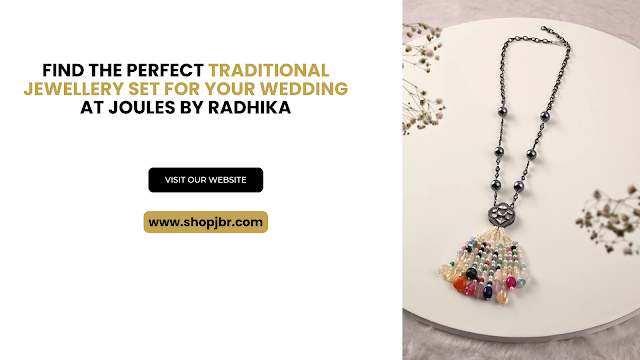Jewels of Identity: The Growing Influence of Indian Designer and Branded Jewellery
Introduction
The Indian jewellery market
is experiencing a renaissance, with Indian designer jewellery taking center
stage. As consumers increasingly gravitate toward pieces that blend tradition
with contemporary design, branded jewellery has emerged as a key player in this
evolving landscape. This blog post delves into the factors driving the growth
of Indian designer jewellery and the significance of branded jewellery in this
competitive market. By exploring the current trends, cultural influences, and
the future of the jewellery industry, we aim to provide insights into this
dynamic sector.
1. The Allure of Indian Designer Jewellery
Indian designer jewellery
has a unique charm that sets it apart in the global market.
- Cultural
Heritage: Each piece
of Indian jewellery reflects the rich cultural heritage of its origin.
Designers draw inspiration from traditional motifs and techniques,
creating pieces that celebrate India’s diverse craftsmanship. The use of
local materials and traditional techniques not only enhances the
authenticity of the jewellery but also supports local artisans and
communities.
- Artistry
and Skill: The
intricate artistry involved in crafting Indian designer jewellery is
unparalleled. Skilled artisans use time-honored techniques, ensuring that
each piece is a work of art that tells a story. Many designers collaborate
with local craftsmen, combining traditional skills with modern aesthetics
to create stunning pieces that resonate with consumers.
- Diverse
Offerings: From
statement necklaces to delicate earrings, the variety of designs available
in Indian designer jewellery caters to different tastes and occasions.
This diversity attracts a broad consumer base looking for something
unique. Furthermore, designers often create seasonal collections that
reflect current trends, ensuring that their offerings remain fresh and
appealing.
2. The Importance of Branded Jewellery
Branded jewellery is
increasingly seen as a symbol of status and quality in the Indian market.
- Assured
Quality: Branded
jewellery offers consumers the assurance of quality. When purchasing from
a reputable brand, consumers can trust the authenticity of materials and
craftsmanship. This assurance is particularly important in a market where
counterfeit products are prevalent, and consumers are willing to invest in
pieces that guarantee quality.
- Exclusive
Collections: Many
jewellery brands release limited-edition collections, enhancing their
allure. These exclusive pieces often feature unique designs that cannot be
found elsewhere, appealing to collectors and fashion enthusiasts alike.
Limited-edition collections create a sense of urgency and exclusivity,
driving consumers to make quick purchasing decisions.
- Brand
Loyalty: Consumers
often develop loyalty to jewellery brands that provide exceptional service
and quality. This loyalty is crucial for brands looking to maintain a
competitive edge in a crowded market. Many brands engage with their
customers through social media, fostering a sense of community and loyalty
that extends beyond the purchase.
3. Key Trends Influencing the Market
The market for Indian
designer and branded jewellery is influenced by several key trends.
- Fusion
Designs: The
blending of traditional and contemporary styles is becoming increasingly
popular. Designers are experimenting with materials, forms, and techniques
to create fusion pieces that appeal to modern sensibilities. This trend
allows consumers to embrace their heritage while making a fashion
statement.
- Social
Media Influence: The rise
of social media platforms has transformed how jewellery is marketed.
Influencers and celebrities showcase designer pieces, driving consumer
interest and demand. Social media marketing strategies, including
collaborations with influencers and targeted advertising, have become
essential tools for brands looking to reach younger consumers.
- Online
Retail Growth: E-commerce
has revolutionized the jewellery shopping experience. Brands are
leveraging online platforms to reach a wider audience, offering convenience
and accessibility to consumers. The ability to browse extensive
collections and make purchases from the comfort of home has reshaped
consumer behavior, leading to a surge in online sales.
4. Looking Ahead: The Future of Indian
Designer and Branded Jewellery
The future of the Indian
jewellery market looks bright, with several factors contributing to its growth.
- Innovative
Designs: As
consumer preferences continue to evolve, designers will need to innovate
to stay relevant. This includes experimenting with new materials, designs,
and techniques that resonate with a diverse audience. Brands that
prioritize creativity and uniqueness will likely thrive in this
competitive landscape.
- Sustainable
Practices: The demand
for sustainable and ethically sourced jewellery is on the rise. Brands
that prioritize ethical practices and transparency in their sourcing will
attract a growing segment of environmentally conscious consumers. This
shift towards sustainability is not only beneficial for the planet but also
enhances brand reputation.
- Expanding
Global Reach: Indian
designer jewellery is gaining recognition on the international stage. As
designers participate in global fashion events and exhibitions, they are
opening doors to new markets. This global reach presents opportunities for
collaboration and growth, allowing Indian jewellery brands to showcase
their craftsmanship to a broader audience.
Conclusion
The Indian designer
jewellery market is undergoing a transformative phase, with a growing
appreciation for artistry, quality, and cultural heritage. As consumers
increasingly seek unique and meaningful pieces, the allure of Indian designer
jewellery continues to captivate. Branded jewellery plays a crucial role in this evolving landscape, providing consumers
with the assurance of quality and exclusivity. With a focus on innovation,
sustainability, and global expansion, the future of Indian designer jewellery
looks promising, offering a wealth of opportunities for both designers and
consumers alike.




Comments
Post a Comment